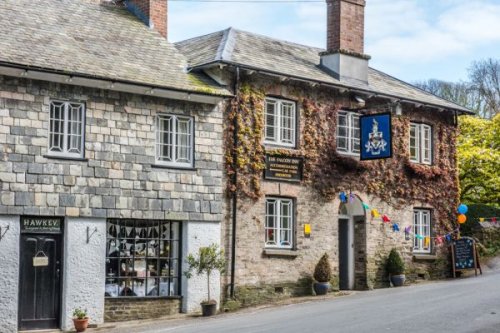


Village between a beach and an airport
St. Mawgan in Pydar Parish Council
St. Mawgan is a village and civil parish close to the north coast of Cornwall. The population of this parish at the 2011 census was 1,307. The village is situated four miles north-east of Newquay, and the parish also includes the hamlet of Mawgan Porth. The surviving manor house known as Lanherne House is an early 16th-century grade I listed building. The nearby Royal Air Force station, RAF St. Mawgan, takes its name from the village and is next to Newquay Cornwall Airport. The River Menalhyl runs through the village and the valley is known as The Vale of Lanherne. It was the subject of a poem by poet Henry Sewell Stokes.
There is evidence of Bronze Age and Iron Age settlements, though the village history proper is considered to start from the arrival of the Welsh missionary St. Mawgan (or Meugan) and his followers in the 6th century when they set up a monastery and the first church. The church was replaced by a Saxon church in the 11th century, which was in its turn replaced in the 11 and 12th centuries by the current parish church.
The Arundell family "of Lanherne" have been the chief landowners in St. Mawgan since the 13th century. It was a branch of the prominent and widespread Arundell family also seated at Trerice.
St Mawgan has a 13th-century parish church, dedicated to St. Mauganus and St. Nicholas. The church was originally a cruciform building of the 13th century but was enlarged by a south aisle and the upper part of the tower in the 15th. The unusual rood screen and bench ends are noteworthy and there are many monumental brasses to members of the Arundell family. The Arundell brasses are mostly in a fragmentary state; parts of some of those originally in the church have been removed to Wardour Castle.
Lanherne
Lanherne House was the manor house for the Arundell family "of Lanherne", lords of the manor of St Mawgan, chief landowners in the parish since the 13th century, many of whose monuments survive in the parish church. They were a branch of the prominent and widespread Arundell family also seated at Trerice, Tolverne, Menadarva in Cornwall and at Wardour Castle in Wiltshire. Lanherne House has been the Lanherne Convent since 1794.
Nanskeval
Nanskeval House was on the parish boundaries of St. Mawgan in Pydar (it was demolished in the mid-1970's) and St. Columb Major: in 1277 it was spelt Nanscuvel. Nanskeval House was once the home of Liberal MP Edward Brydges Willyams and is still part of the Carnanton estate which is still owned by descendants of the same family. Nans means 'valley' in Old Cornish, and Kivell was thought to derive from the Cornish equivalent of the Welsh word ceffyl, meaning a horse. but as the Cornish for horse is Margh this is an erroneous interpretation. Much more likely is "The valley of the Woodcock" as the Cornish for woodcock is 'Kevelek'. The surname Nankivell and its variants are thought to derive from this place.
Arthur Langdon in 1896 recorded two Cornish crosses in the parish: one, a small cross, is at Mawgan Cross and the other at Lanherne. The Lanherne cross is a highly ornamented example and stands in the grounds of the nunnery having been brought from Roseworthy in the parish of Gwinear. "It is the most beautiful specimen of an elaborately decorated cross in Cornwall." Andrew Langdon in 1994 records four crosses. These are the Lanherne cross, the churchyard cross, Bodrean Cross and Mawgan Cross.
St. Mawgan has been a major centre for Cornish wrestling over at least the last few centuries. Matches have always been held on the recreation ground in churchtown.
St. Mawgan Steam Rally - Third weekend in September.
Newquay Mawgan Porth Lanherne The Japanese Garden and Bonsai Nursery